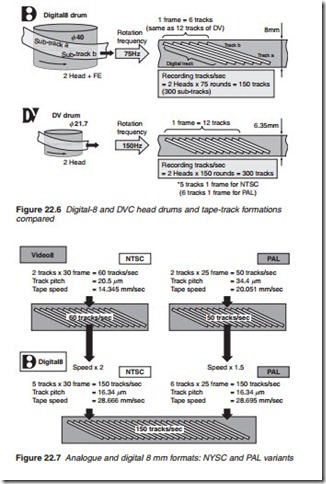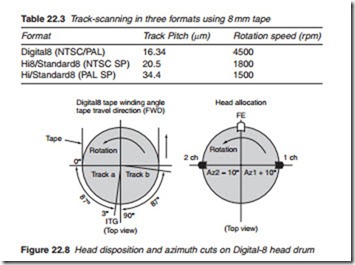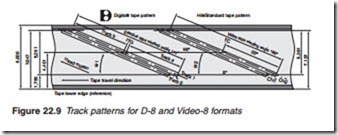Digital-8 format
The Video-8 and Hi-8 analogue formats are much better suited to portable (camcorder) operation than VHS ones; the smaller cassette makes for a smaller and lighter machine, even lighter than those VHS-C (C for com- pact) cassette. The Video-8 formats were developed specifically for porta- bility, while VHS was adapted from the basic large cassette/home deck concept developed by JVC in the 1970s. In an attempt to maintain their market lead, and to provide a ‘bridge’ between analogue and digital sys- tems for existing users, the inventor of Video-8, Sony, introduced a new ‘dual’ D-8 (Digital 8) format. D-8 decks (virtually all of them in camcorder form) can replay analogue Video-8 and Hi-8 recordings as well as their own digital recordings, using the same head pair, drum and tape wrap, and the same type of tape. During playback, the type of signal on tape is automatically detected and the replay circuits switched accordingly. If required an analogue signal off tape may be made available in digital form, using an A-D converter inside the camcorder.
D-8 recording system
For compatibility the Digital-8 head drum must necessarily conform to the 40 mm diameter of the Video-8 format. Figure 22.6 compares D-8 and DVC- format tape-track configurations. While the PAL–DVC system records each TV frame in 12 tracks, D-8 lays down a frame in six tracks, each divided into two consecutive sub-tracks. To achieve this the D-8 drum speed is 4500 rpm. Figure 22.7 shows at the top a comparison between the NTSC and PAL vari- ants of analogue Video-8 format, with one track per frame in each case: for NTSC the tape speed is slower and the tracks narrower than for PAL. The lower section of the diagram illustrates that tape linear speed is virtually the same in Digital 8 for both TV systems, with five (NTSC) or six (PAL) tracks per frame, all tracks being 16.34 microns wide. Both trace 150 tracks/s, 30 five-track frames for NTSC and 25 six-track frames for PAL. Digital-8 video heads have a width of 19 microns, a little wider than the D-8 track pitch (each
new head sweep erases the excess of its predecessor during record), and somewhat narrower than the Video 8/Hi-8 tracks of any analogue tape which may be presented. In the latter case, the heads sweep along the centre of the pre-recorded tracks, the signal they produce displaying slightly higher S/N ratio than would come from a correct-width head. Table 22.3 shows the track pitch for D-8 and the variants of video-8: the drum is designed to rotate at 1500 and 4500 rpm in European D-8 decks. Figure 22.8 shows the disposi- tion of the three heads on the 40 mm-diameter drum, and their azimuth set- tings, ±10º for compatibility with Video-8 and Hi-8 recordings. The track patterns on tape for D-8 and Video-8 are shown in Figure 22.9. The track- following servo system for D-8 is the same as that already described for DV: 465 and 697 kHz tones are recorded in alternation with no-tone head-sweeps
in a four-track sequence, ATF error being detected only in playback of no-tone tracks. When replaying an analogue recording the servo system switches to Video-8 ATF operation as described in Chapter 21.
Because of the two sub-tracks per head sweep of the D-8 tape pattern, and the fact that drum rotational speed is half that of a DVC drum, the off-tape RF signals during digital replay are identical to those of DVC as Figure 22.10 shows.


